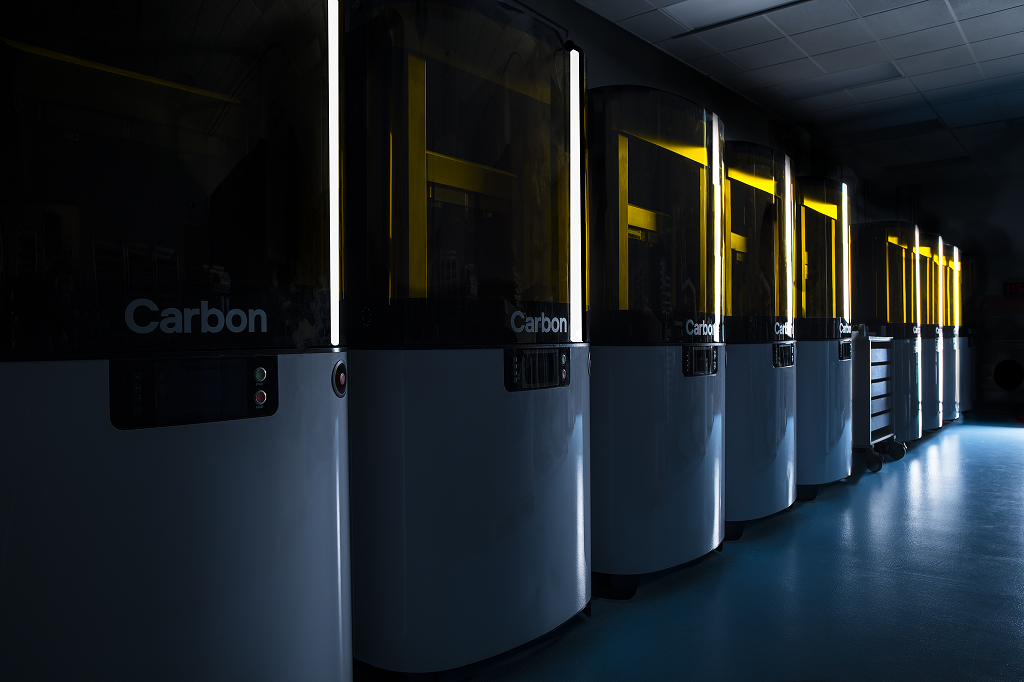![L1s in the lab [Image: Carbon]](https://fabbaloo.com/wp-content/uploads/2020/05/CarbonL1sLab_img_5eb09d92c5446.png)
Carbon has made no secret of its manufacturing aspirations, and the new L1 is the next step in hardware for “immediate, high-volume production.”
In 2015 the company introduced stunningly fast 3D printing. In 2016, Carbon unveiled its subscription-basis M1 3D printer. In 2017, production was more squarely in sights with the SpeedCell system and M2 3D printer, followed by a new bulk materials program targeting production volumes. The focus on bulk materials served as an answer as to how big Carbon’s aspirations in large-scale manufacturing might be. In 2018, that was further clarified with a significant price reduction for resins based on high-volume demand. In 2019, we’ve already seen scale production use with a deepening partnership with Ford building on Carbon’s well-known work with adidas for 3D printed shoe midsoles.
Today, Carbon takes the next step in ramping up its positioning in digital manufacturing with the L1.
Fully 10x the size of the initial M1 (and 5x the size of the M2), the build area of the L1 is designed for production, bearing multiple parts per build. The scaleup is referenced in the names of the systems; “M” for medium, so “L” for the new large.
The L1, Carbon makes very clear, is not for everyone: they mean it when they say high-volume production. Because the L1 works as part of Carbon’s subscription-based network that ensures close relationships, this new equipment works best in a collaborative partnership that can bring Carbon’s expertise together with the customers’ specific needs.
“Products need to be validated by Carbon in the design phase in order to be printed on an L1 to ensure quality. L1s are not intended for general purpose printing,” Carbon says.
The production process with the L1 encompasses several steps. Carbon describes them:
-
Start:
-
Customers start with their own product design files in the STL file format.
-
-
Pre-Printing:
-
Before printing, design files must be assembled into printing projects. Carbon software tools automate this process, including embedding unique part identification codes for quality control.
-
-
Print
-
The L1 printer grows parts from liquid resin using DLS technology. Carbon’s high volume solutions often include unique hardware tools for preparing resins in large quantities.
-
-
Clean
-
To ensure the best accuracy and surface finish, extra liquid resin is removed from the part. Carbon uses automated cleaning solutions to ensure consistent, high quality parts.
-
-
Bake
-
Parts are thermally cured in ovens to set the final mechanical properties.
-
-
Finish
-
Parts are ready for Quality Assurance testing where their entire production history has been logged. Parts that pass QA are ready for end use.
-
The L1 is already in use, and now that limited basis availability has the opportunity to widen. The Futurecraft 4D midsoles created with adidas are a major use case for the L1; Carbon notes that 100,000 pairs of 4D midsoles were produced in 2018 — and they’re looking to scale up to the millions
The clever design of the lattice structure on the 4D midsole is increasingly becoming a benchmark for success in scale production with 3D printing. Carbon worked closely with adidas to develop just the right solution, as intentional design and smart structuring were necessary to create an actually-optimal lattice design rather than one that’s just for show. Such partnership with strong results is a major part of why the close relationship with customers is a must for Carbon.
Another existing user, Riddell, has been putting the L1 to use to create customized helmet liners for football — the first digitally manufactured liners to come to market. The SpeedFlex Precision Diamond is an interesting use case: we go into more detail on the partnership and its implications here.
![A Diamond Helmet in an L1 3D printer [Image: Carbon]](https://fabbaloo.com/wp-content/uploads/2020/05/DiamondHelmetinL1printer_img_5eb09d937ae15.png)
Also notable is this claim:
“Through their partnership with Carbon, adidas and Riddell are two of the largest users of 3D printers in the world.”
Carbon isn’t just talking a big game when it comes to production. They’re actively working on realizing scale manufacturing with digital solutions.
The L1 is available now, on a limited basis. Remember that validation process? Potential customers are encouraged to reach out to Carbon’s sales team for details on how to proceed with interest.
The M2 remains available, and Carbon notes that “the M1 will be available on a more limited basis” as they continue to look to the future of the Carbon Platform. That’s one bright side of a subscription service; users will never be left in the dark about new innovations and can continue to adapt as portfolios grow.
Digital Light Synthesis is, no question about it, a manufacturing technology. As 3D printing continues to industrialize, we’ll continue to see more scale production from next-generation additive manufacturing solutions. And it will be no surprise to see the Carbon team standing behind new products hitting the market.
Via Carbon











The fate of major 3D printing conferences in 2020 is unclear with the ongoing virus outbreak. We have thoughts on what it could mean.